WAKE ME UP, WHEN WE GET THERE!
GREAT SAND DUNES NATIONAL MONUMENT IN COLORADO




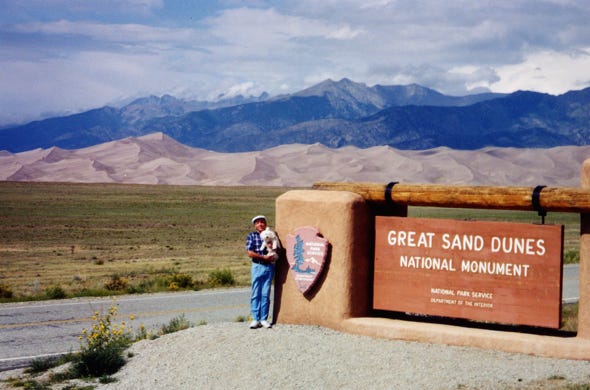
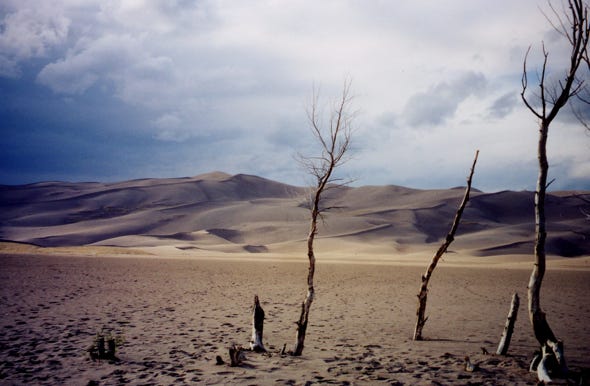
As we were driving on the two-lane road in the park, we approached a turnout and drove in and saw the dunes in a different mood, the storm clouds and shadows of this barren landscape. We said that we should get into the Pinyon Flats campground and find a spot for the night as the clouds were getting closer and the wind was beginning to blow. At the campground, you will find 88 camping spots with fire grates, picnic tables, drinking water, and flush toilets.
We drove the two loops to find a level site for our camper and boat. Since this was late in the afternoon many larger sites were already taken, but after driving the loops several times we settled in on a site and unhooked the boat. Then came trying to level the camper since the site was out of level. I got out all of our level blocks as Bill was telling me which side needed the most, after several tries, we finally got the camper level. One thing we said to each other was that we were glad that we did not have our 34-foot trailer with us since there were very few sites that could hold such a large unit. The restrictions for vehicle length are 32 feet, and turning the corners of the loops would be impossible if we had our trailer with us since our total length is over 60 feet. Before you enter the park, there is a private campground where you can park your large RV and then drive in with your tow vehicle or car.
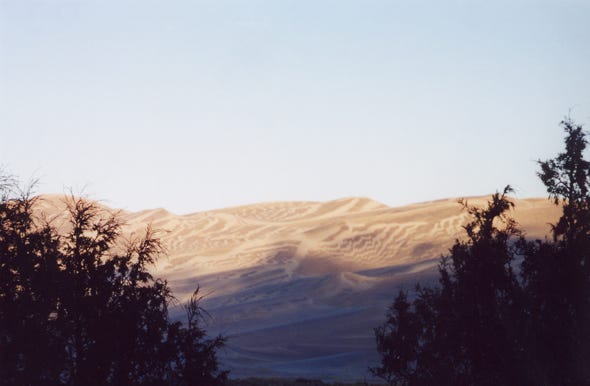
I looked out to the dunes and saw the storm approaching and the wind blowing in the distance, I got Daisy out of the camper for a quick walk, we had very little time because immediately after I got her back into the camper the storm hit. I called out to Bill who was outside verifying that the boat was safely parked and that the truck windows were up. Bill came running into the camper just in time as the storm approached with winds over 40 miles per hour. You could not even see the dunes, we sat inside the camper and saw other campers’ tents go flying into the distance, with the wind and rain all we could do was just look outside at the severe storm.
We thought about all the people still hiking the dunes and hoped that no one got lost in this severe storm. This is something that you should be aware of when hiking the dunes, the winds can blow hard and cause poor visibility.
The storm lasted for 15 minutes, but it seemed longer, and when it was all over, and the skies cleared; we saw this beautiful rainbow.
We had dinner and planned our next day’s activities, along with watching some TV on our satellite dish. Throughout the night, we could hear on the camper roof the pitter-patter of the rain falling and thought to ourselves that we hoped that it would clear out by the morning so that we could hike up to the top of the dunes.
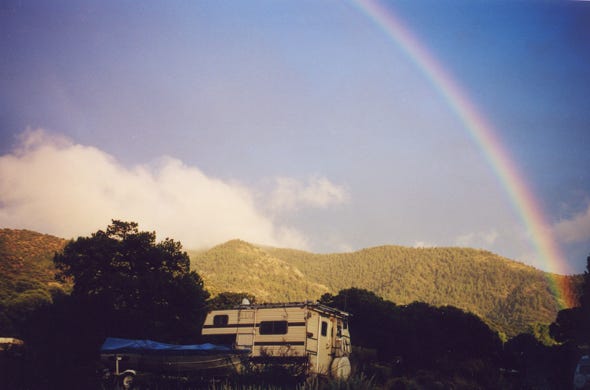
The morning came with blue skies and as the sun started to rise, I ran out to take this picture of the effect that the rain had on the sand dunes; it seemed to give more depth to them. We had breakfast and then drove to the turnout, where we gathered our lunch and water bottles for our hike to the top.
Since temperatures can still climb into the 80s in mid-September, we found a large shade tree to park the camper under and walked Daisy. We had several bowls of water for her and had two fans on in the camper to keep it cool for her. We decided to hike in our tennis shoes, long pants, a hat, and sunglasses. We packed in our backpack a light jacket and many rolls of film.
During the summer the temperature of the sand can reach over 140º, so you should hike the dunes in some type of protective footwear. Allow at least two hours to hike the dunes and carry water with you.
As we started our hike we wondered if we could make it to the top, since you have to cross the long flat dry stream bed called Medano Creek before you even get to the bottom of the dunes. Medano Creek in the spring and early summer has water running at the base of the dunes and the young and old can build sand castles as though they were at the ocean.
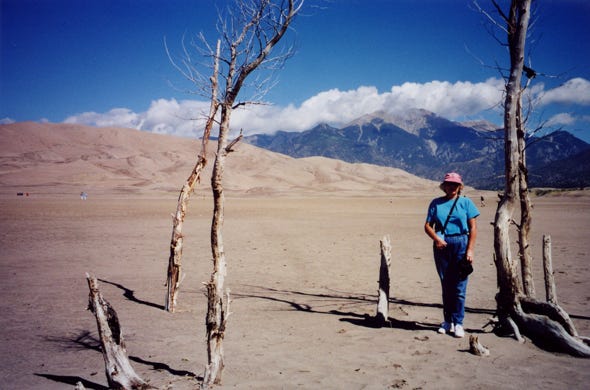
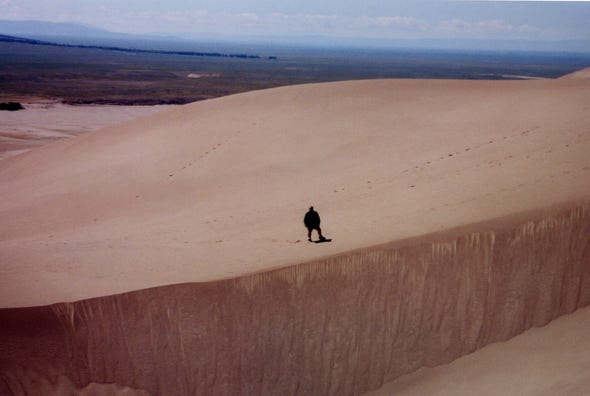
On our way to the top, we met a couple who come to the dunes every year to cross-country ski down the slopes. We saw them traverse across the sand, you would think that they would sink in the deep sand but as in the snow, the skis kept them from sinking.
As you can see in the picture, they made it to the top skied down the slopes, and then walked back to the top to do it all over again.
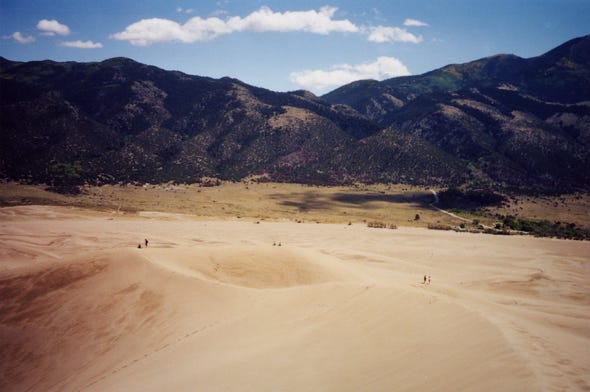
At the top of the mountain, we looked out at the scenery sat down, and had our lunch observing other people climb to the top, and taking pictures of this very unusual area.
If you are hiking the dunes and you see thunderheads or hear the sound of thunder, get off the dunes immediately and head for shelter. Since you are in a large open, barren area, lighting can strike at any time. Most of this happens in the summer months. If you want to take your pet with you, it would be best to hike early in the morning or late afternoon since the sand can get very hot and burn the pet’s feet.
Before heading out on your hike, observe the routes that other people are taking and follow that route, since as we found out you can crisscross back and forth and up and down to finally get to the top. Another thing is to go to the Visitor's Center and get information about the area, trails, campground, and backcountry information, they will also help you plan your best route to the dunes. The Great Sand Dunes National Monument is open all year. In the summer, the Visitor's Center is open from 9:00 a.m. to 6:00 p.m. daily, from Memorial Day to Labor Day. In the winter, the hours are 8:30 a.m. to 4:30 p.m. daily, except for Christmas Day and New Year's Day, when the building is closed.
We continued to walk in the deep sand sinking sometimes to 12 inches below the surface and said that we were glad that it rained the night before since it did keep the surface of the sand more compacted. As we crossed the flat dry stream bed and worked our way up the slopes to the top, we saw a man at the edge of a large crevasse, looking down pondering what to do, hike down and up again to the other side or go back and find a different route, this is why it is important to plan your route and follow the main trail to the top.
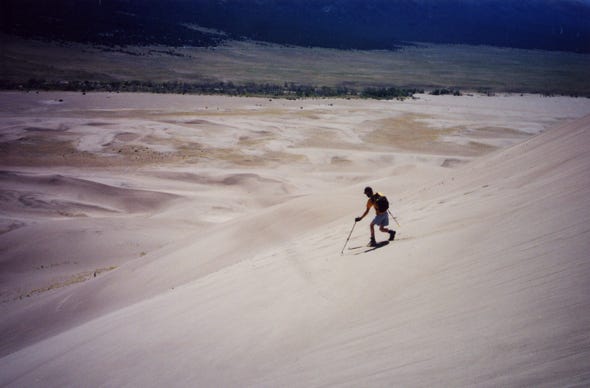
We continued to climb the dunes, going over one ridge to another and as we looked back at the dunes, the mountains, and the scenery were spectacular. You barely see other people climbing up the hill, little specs in a vast area.
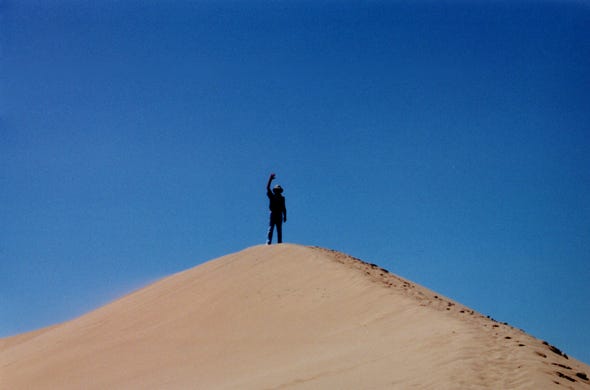
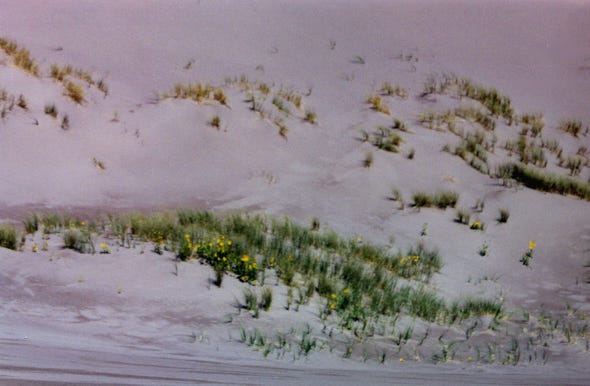
After a long day, we came back to the camper and Daisy greeted us with excitement, we were glad that we had shade for her and that the camper stayed cool. Most pet owners know not to leave their pets in their cars, but sometimes people think that they will be gone only for a few minutes, and they often forget that the temperature inside a vehicle can get to over 100º in just a short time.
We drove back to the campground and looked back at the dunes and where we hiked to and said that we were glad that we hiked to the top and experienced such a wonderful place.
As you can see by the photo, the ridge, or crest of the dunes has folded over in the opposite direction. This happens when strong winds blow from the northeast; the reversing dunes are called "Chinese Walls."
Remember that you are at an elevation of 8,200 feet and that it takes a while to get acclimated to the elevation. Some people can experience headaches, fatigue, shortness of breath, and dehydration. Drink plenty of water and take it easy for the first few days.
We had a great time hiking the dunes and as we started on our way back to Daisy in the camper, we noticed several areas of wildflowers.
It's hard to imagine in this desert area that anything could grow, but if you dig down in the sand 8 to 10 inches you will find moist sand.
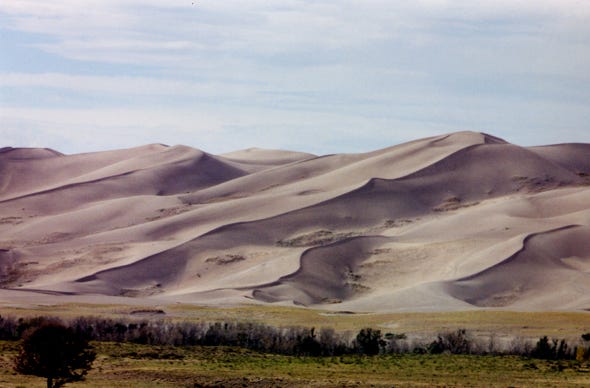
When you stop in at the Visitor's Center, be sure to take the short walk which is also wheelchair accessible called "The Story Of The Dunes Trail." If you have more time, then there is the 1/2 mile trail called "Montville Nature Trail" which is 1/4 of a mile North of the Visitor's Center. If you are camped in the campground and want to go for a scenic hike, go to loop 2 and start the trailhead near the second bathroom, called the "Little Medano Trail" and hike north to Point of No Return; if you do not want to come back on the same trailhead, then walk the Medano Pass Primitive road to return. The views of the dunes are excellent.
There is a daily entrance fee of $3.00 per person; children under 16 are free. The campground fee is $10.00 per night and if you have a Golden Age or Access passport, the campground fee is $5.00, and the entrance fee is no charge. Group camping is by reservation only, and the charge is $3.00 per person; you can call the Visitor's Center at 719-378-2312 ext. 220 to make reservations.
We had a great trip, sightseeing this area, but now it is time to head south, to explore another area, another state, all we can say is, "Come travel with me, and here is what you will see."